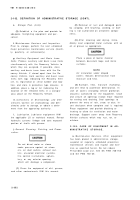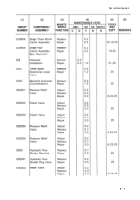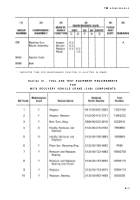TM-9-2350-238-20-2 - Page 398 of 495
TM 9-2350-238-20- 2
B-2. MAINTENANC E FUNCTIONS (CONT) .
f.
Caibrate.
To determine and cause corrections to be made or to be adjusted on instrument s
or test, measuring, and diagnostic equipments used in precision measurement. Consists of com-
parisons of two instruments, one of which is a certified standard of known accuracy, to detec t
and adjust any discrepancy in the accuracy of the instrument being compared .
g.
Remove/Install.
To remove and install the same item when required to perform service or
other maintenance functions. Install may be the act of emplacing, seating, or fixing into a posi-
tion a spare, repair part, or module (component or assembly) in a manner to allow the proper
functioning of an equipment or system .
h.
Replace.
To remove an unserviceable item and install a serviceable counterpart in its place .
“Replace”
is
authorized
by
the
MAC
and
is
shown
as
the
third
position
code
of
the
SMR
code.
i.
Repair.
The application of maintenance service s
2
,including fault location/troubleshootin g
3
,
removal/installation, and disassembly/assembl y
4
procedures, and maintenance action s
5
to identify
troubles and restore serviceability to an item by correcting specific damage, fault, malfunction ,
or failure in a part, subassembly, module (component or assembly), end item, or system .
j.
Overhaul.
That maintenance effort (service/action) prescribed to restore an item to a com -
pletely serviceable/operational condition as required by maintenance standards in appropriat e
technical publications (i.e. , DMWR). Overhaul is normally the highest degree of maintenance per-
formed by the Army. Overhaul does not normally return an item to like new condition .
k.
Rebuild.
Consists of those services/actions necessary for the restoration of unserviceabl e
equipment to a like new condition in accordance with original manufacturing standards. Rebuil d
is the highest degree of material maintenance applied to Army equipment. The rebuild operatio n
includes the act of returning to zero those age measurements (hours/miles, etc.) considered i n
classifying Army equipment/components .
B-3. EXPLANATION OF COLUMNS IN THE MAC, SECTION II .
a.
Column 1, Group Number.
Column 1 lists functional group code numbers, the purpose o f
which is to identify maintenance significant components, assemblies, subassemblies, an d
modules with the next higher assembly. End item group number shall be
″00″.
b.
Coumn 2, Component/Assembly.
Column 2 contains the names of components, assem -
blies, subassemblies, and modules for which maintenance is authorized .
2
Services–inspect, test, service, adjust, aline, calibrate, and/or replace .
3
Fault location/troubleshooting—the process of investigating and detecting the cause of equip -
ment malfunctioning; the act of isolating a fault within a system or unit under test (UUT) .
4
Disassembly/assembly—encompasses the step-by-step taking apart (or breakdown) of a
spare/functional group coded item to the level of its least componency identified as maintenanc e
significant (i.e. , assigned an SMR code) for the level of maintenance under consideration .
5
Actions—welding, grinding, riveting, straightening, facing, remachining, and/or resurfacing .
B-2
Back to Top




















